THE PASTAGA OF LÉOUBE
by Pamela O'Neill
In August of last year, Château Léoube’s Secret de Léoube was given a shout by Drinks Magazine, having placed in the gold medal tier of their 2014 Global Rosé Masters wine tasting competition with such local Provence favorites as Château d’Esclans and Mirabeau en Provence. Embarrassingly enough, having lived only an hour away for years, I had been blissfully ignorant of this domain. As Provence Winezine’s on-the-spot reporter, I could hardly resist the urge to sniff about for more tidbits on this upstart rosé. I belatedly learned that Château Léoube may have been a new kid on the block but had also been collecting kudos from the likes of Decanter’s World Wine Awards and the Concours Mondial de Bruxelles, among others. Oh, mercy.
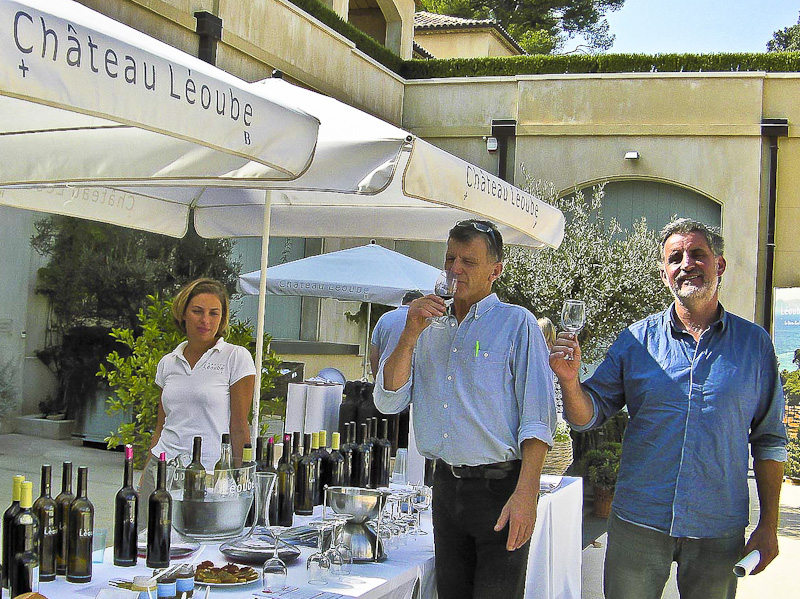
Friends, Richard Burbidge and Mike Doran, savoring Léoube’s trio of reds at the portes ouvertes. Photo by Pamela O’Neill
I nosed on and discovered, Bacchus be praised, that in a week’s time, the château was to host a portes ouvertes, inviting one and all to visit the domain and sample their new selection of 2014 reds. So packing up my camera, my friends, and my dog, bound for the Côte d’Azur, the hub of the hubbub, I could taste redemption in the approaching sea air. Although still not able to make the acquaintance of the heralded rosés—they were completely sold out—the day was a grand success. The Léoube welcome was chaleureux, the environs pristine, the reds well worth the jaunt (and my job intact). This was, however, but a first glimpse across a crowded tasting room: intriguing and alluring but just a visage.
With curiosity piqued, and still stalking the elusive rosés, I ventured back to Château Léoube in July, this time with Susan Manfull, to see what lay behind its pretty face. Arriving mid-morning for our rendezvous with sales and marketing director Jérôme Pernot, it was already a thousand degrees, or there about, in the shade. Understandably, both Susan and I were deliriously grateful to discover that our scheduled safari through the vineyards was to be conducted in the comfort of a blessedly air conditioned Land Rover. What we had failed to anticipate was the vertebra-thumping ascent up a serpentine dirt road (read goat path), unmasking the true reason for the tenacious vehicle.
Thirty minutes later, when we alighted on a craggy bluff, tumbling shell-shocked from the wild Rover, we were abashed to discover that, far from being a test of our true grit, our white knuckle ride had granted a gift: a glorious panoramic bird’s-eye vista of the entire domain – the size, the beauty, and the privileged position would have been impossible to grasp at vine level. A painterly patchwork of vineyards and olive groves stretched out before us in infinite hues of green and brown and grey. Rectangular parcels of land, dotted with perfectly symmetrical rows of trees and vines, cascaded to the very edge of the sail-flecked, glittering sea, with the Hyéres Islands marking the horizon.
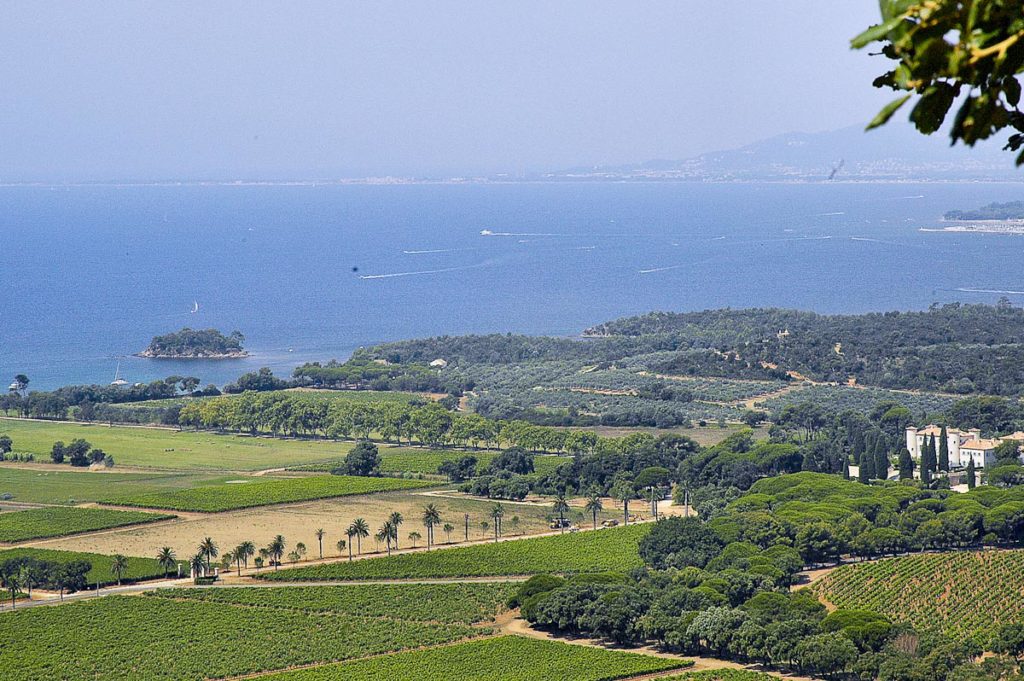
A birds-eye vista of the Léoube estate with l’Ilot (small island) de Léoube just off shore, the Giens Peninsula on the horizon, and the château, surrounded by trees, on the coastal plain. Photo by Pamela O’Neill
Located in the village of Bormes-les-Mimosas, this vast 560-hectare (1,384-acre) estate lies just seven miles east of Hyéres on the western shore of the Cap Bénat peninsula. Roughly half way along the Bay of Hyéres, formed by the Giens Peninsula to the west and Cap Bénat to the east, Léoube occupies an imposing four kilometers (2.5 miles) of rocky shoreline and white sand beaches along the Mediterranean coast, making it the largest privately owned frontal property on the Côte d’Azur. From the shore, past the agricultural plain, where the vines and olive trees are cultivated, the domain climbs into the forested Massifs des Maures—the “dark” mountains—which rise to the north, paralleling the coast, and also to the east, where they form a perpendicular fingerpost pointing down the middle of the Cap Bénat peninsula to the sea.
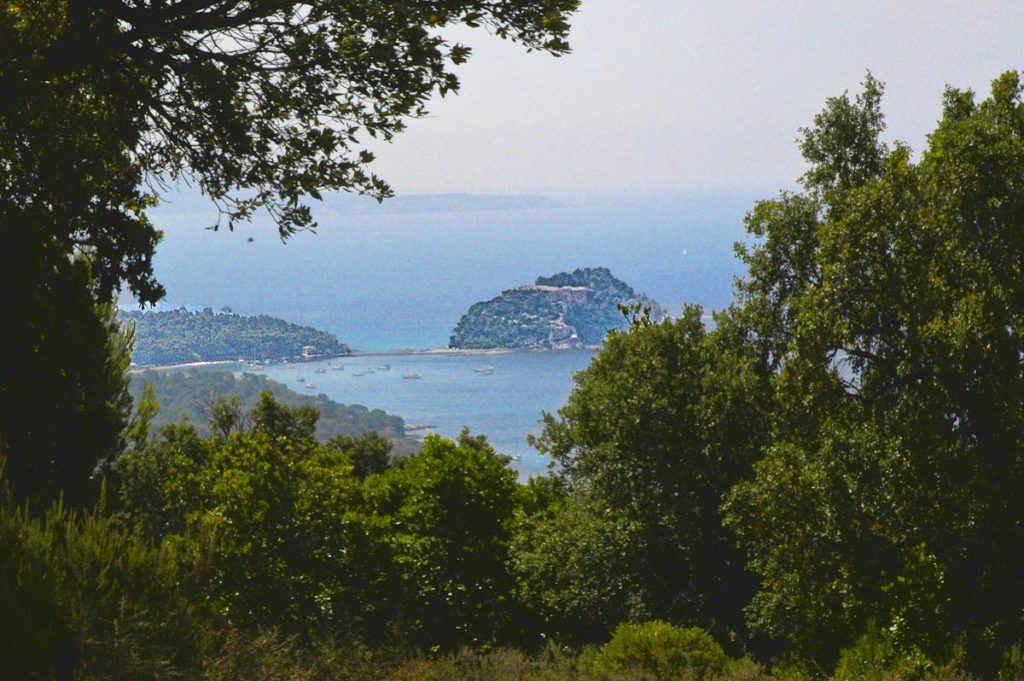
Fort Brégançon, classified historical monument and former summer residence of the Presidents of the French Republic. Photo by Pamela O’Neill
This finger was where we stood, surrounded on three sides by tens of thousands of acres of Aleppo, Umbrella, and Maritime pines, cork oaks, craggy rock, and maquis. Enveloped by a copse of trees, Léoube’s château, which stands guard over the coastal plain, was clearly visible from our elevated perch. Curiously, I have found little historical information on the château, which has been variably dated from as early as the 14th century to as late as the 17th. Jérôme politely requested that I refrain from taking telephoto shots of this furtive castle, making it all the more mysterious and compelling. Looking down the Cap, through the pines, we could also just see Fort Brégançon, classified historical monument, sentinel of the bay, and former summer residence of the Presidents of the French Republic.
What is truly remarkable is that much of this long-chronicled property has been preserved throughout its tumultuous history. There is archaeological evidence of occupation from Neolithic time and vestiges of habitats confirming occupation from the Iron Age. Léoube, in ancient time called “l’Eolbe,” was long propounded as the site of the Greek city of Olbia, remains of which have since been excavated in Hyéres. Some historians still believe that the Phoenician settlement of Olbia, predating the arrival of the Greeks, was indeed located here. Among other remnants, tiles used in Roman tombs, stamped by the fabricator, have been unearthed and the Gallo-Roman Chapel of Saint George still stands atop a hill overlooking Léoube Beach. A garrison, commissioned by Napoleon in 1810 to defend against the looming threat of British naval attack, and partially demolished by Nazi troops during WWII, sits on the rocky precipice of Cap Léoube.
Owing to its strategic coastal position, accessible via several coves and beaches, and flanked on two sides by the Maures mountains, the Léoube land has been looted, sacked, invaded, and occupied by every marauding tribe and seafaring conqueror of the past 2500 years. Notable hooligans included the Ligurians, Celts, Bormani, Romans, Franks, Saracens, Moors, and Germans, right up to the landing of allied forces in Operation Dragoon on August 15, 1944. Most recently, the Léoube domain also survived the building frenzy of the post-war 20th century, which devoured the Côte d’Azur from Le Lavandou, just around the tip of Cap Bénat, as far as the Italian border as well as spurred the urban sprawl of Toulon and Hyéres impinging from the west.

Allied forces’ landing plan for Operation Dragoon (originally called Anvil), the invasion of southern France on August 15, 1944.
Armchair research into past proprietors of Léoube left me brain boggled and reaching for vino therapy – so proceed with grain of salt. Its early history, as that of Provence, is a quagmire of ownership bouncing between a litany of counts of Provence, and, later, the French crown. Although I was not able to determine when the lordship of Léoube was established, it could have been as early as the 10th century, after expulsion of the Saracens, around the same time as its neighbor, Brégançon (972). The lordships of Léoube and Brégançon were often assigned together by the reigning counts until definitively separated in 1679, when Léoube was sold into private ownership while Brégançon reverted to the crown.
In 1766 (following yet another stint under the crown), the Bremond family, “agriculturists” (viniculturists perhaps?) in Collobrières, purchased the estate. It appears that one such “Bremond de Léoube,” mayor of Bormes at the time, ran afoul of the radical Jacobins and was charged with being an enemy of the revolution during the Reign of Terror. Apparently, in 1791, he had ordered a lieutenant of the national guard at Fort Brégançon not to fire on English ships in the Bay of Hyéres (perhaps boding well for future British owners), which had been helping to evacuate the understandably terror-stricken royalists and others fleeing revolutionary mayhem. I do not know if poor Bremond himself managed to flee his accusers or indeed met “Le Grand Rasoir National.”
Nevertheless, with or without his head, some Bremond remained at Léoube until Toulon industrialist Emile Joseph Gérard acquired it in 1840. I’m going out on a limb to say that this must be the very same Emile Joseph Gérard who, in 1847, bought the Étang des Pesquiers (pond of fisheries), which covers most of the Giens Peninsula of Hyéres, and was, at that time, beset with mosquito infested mud flats. From these swamps he created Les Salins des Pesquiers, a 538-hectare salt marsh that, while vanquishing malaria, provided much needed enterprise until operations ceased in 1995. It is now a stunning nature preserve.
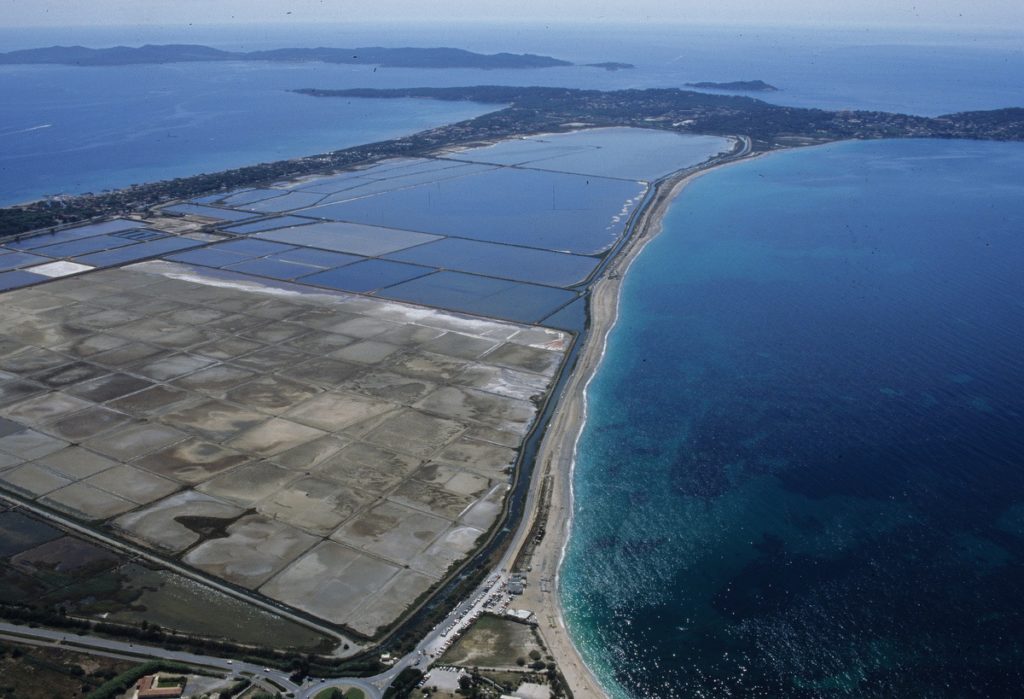
Salt flats of the Étang des Pesquiers, on the Giens Peninsula of Hyéres, built by Emile Joseph Gérard, owner of domaine de Léoube, in 1847. Photo used with permission of the Conservatoire du littoral.
Subsequent to this period, reports of comings and goings at Léoube have been conspicuously elusory. A real estate advertisement published in Le Figaro does show the property for sale in 1854, announcing “Domaine de Léoube: The most beautiful property on the coast,” with 610 hectares of land including 75 hectares of “vines and crops” with a sale price of 1,000 francs.
I found a fleeting reference (remember your salt) to one former 20th century proprietor, quite high profile at the time. Georges-Marie Haardt, general director of Citroën in its infancy, was famous for leading never-before-attempted expeditions over demanding and inhospitable terrain to prove the moxie of the modern automobile, more specifically his beloved Citroën. He conducted two successful and widely publicized expeditions to Africa but met with his demise on a voyage across Asia, sadly felled by frigid conditions and pneumonia. Purportedly owner of both Domain Léoube and its old friend Brégançon at the time, perhaps Monsieur Haardt had become habituated to the kinder Mediterranean climate.
Two farsighted events did transpire in this century, however, which were paramount in ensuring Léoube’s longevity. In 1942, shortly after the death of their trail-blazing owner, both Brégançon and Léoube became listed historical sites. And in 1975, an entire 1,700 hectares of Cap Bénat, including both domains, was made a “site classé” under permanent protection of the French government.
But the epoch that transformed an unknown wine domain into Château Léoube, producer of trumpeted rosé, began in 1997 with the arrival of a new lord. He is the ennobled Lord Bamford, Baron of Daylesford and of Wootton, and Chairman and owner of JCB, the world’s third largest construction equipment manufacturer. According to a 2015 article in Forbes Magazine, “a JCB is to a backhoe what a Kleenex is to a tissue,” but with profits of over a million pounds a day. His wife is Lady Carole Bamford, England’s pioneering queen of organic farming, who W magazine, in 2007, described as a “superposh, organic, British Martha Stewart.” From its humble beginnings in 2002, selling from a renovated barn the cheese, meat, and vegetables produced on the Daylesford estate, she has grown her business, Daylesford Organics, to include a cooking school, a string of London cafe/farmshops, a wellness center, clothing and cosmetics lines, and a charitable foundation.
Though not originally intending to purchase a wine domain when house hunting on the Côte d’Azur, once installed there, it is only natural that this audacious duo would be enticed into applying their business acumen and environmentally sustainable farming principles to Léoube’s lackluster vineyards and groves. With an army of JCB tractors and diggers at the ready, all they lacked was wining and vining savoir-faire. Being perfectionists, not any old wine (or winemaker) would do: the Bamfords aspired to make an intrinsically Provençal style wine of the very highest quality that would showcase the singularity of the terroir. So they poked their heads over the fence and asked the advice of their neighbor. This would turn out to be a most fortuitous inquiry, providing a key ingredient in the Hegelian cocktail that was to metamorphose the Léoube estate and its wines.
Who, you ask, was this neighbor? None other than Jean-Jacques Ott, third generation of preeminent Domaines Ott* winemakers. This renowned domain was started by his grandfather Marcel, “who would become famous for his thorough research, attention to detail, great patience, immense discipline, and exceptionally high standards of quality” (see Provence Winezine) and first brought Provence wines to international attention.
At the time of the Bamford’s arrival, Jean-Jacques was noodling with the notion of retirement and plans were afoot to liquefy Domaines Ott* assets in order to resolve inheritance obligations toward the numerous fourth generation Ott offspring (which resulted in its purchase by Maison de Champagne Louis Roederer in 2004). Well, you guessed it; he succumbed to the siren call of a new challenge, and offered his own prodigious expertise to the Lord and Lady of Léoube in their quest to realize a strikingly Marcel-like vision.
In 2003, after obtaining a degree in agricultural engineering, specializing in oenology, Jean-Jacques’ son, Romain, was also brought on board. When Jean-Jacques retired, he ceded his reins to the fourth generation Ott winemaker, although Jérôme tells us that Jean-Jacques can still be spotted among the vines some mornings and is still available for “fine tuning” in the cave.
In addition to the Bamford-Ott dream team, Léoube’s microclimate and topography provide an ideal viticultural milieu, making an inestimable contribution to the potential for creating distinguished wines. On average, there are over 3000 hours of sunshine per year (arguably more than anywhere else in France), the Mistral winds from the north-west insure the vines are kept dry and disease-free during the hot summer months, salty sea breezes flavor and cool the vines at night, and the earth is a mineral rich combination of sand, mica schist, and clay. Nature is not without its perils, however. Winds from the east, most frequent in spring, fall, and early winter, can at times bring heavy inundations, leaching the vineyards of their topsoil and forming tremendous canyons of runoff, which can severely damage the vines or even wash them out to sea.
So job one for team Bamford-Ott in their mission to nurture nature was a massive restructuring of the vineyards. Starting with a triage of the original forty-odd hectares, all fields have been re-soiled, leveled, terraced, reoriented, and/or canted depending upon their position and soil composition. With the same deliberation and exquisite attention to detail lavished on each step of the process, it takes a full ten years from the time this ground preparation is begun on a new parcel of vineyard for the wine it produces to be ready to drink.
It was not until 2008 that the first wine deemed worthy of the Château Léoube name was bottled and distributed in France, the same year that the entire domain received Ecocert organic certification. With their guiding philosophy to “Produce the best from what the land can give you with great affection and care” and a combination of deep pockets and ancestral savvy, seven short years later, the estate now boasts 65 hectares of vines, a new state-of-the-art cave, eight outstanding cuvées, two estate olive oils pressed from the fruit of 4700 trees (using a brand-new olive mill), international distribution of its wines, and countless accolades. One can’t help but feel both impressed and woefully unaccomplished.
All of which begs the essential nagging question: Did Susan and I finally get to savor the bemedaled rosés? We did indeed. But, alas, there was not a bottle to be had, short of mounting a raid on the château’s private cellar (which we considered) of the new cuvée Léoube La Londe. We will be forced to return, kicking and screaming, in June of next year to sample this nectar touted as a “Super Rosé,” having taken 10 years to perfect, with only 1,500 bottles to go around. But Jérôme did treat us to the other pink sweethearts of the press, for which we’d been lusting.
Both the Rosé de Léoube and Secret de Léoube undergo natural alcoholic and full malolactic fermentation in stainless steel tanks, no wood. They are both concocted from, 40% each, Grenache and Cinsault grapes. The remaining 20% of the Rosé de Léoube is blended from equal parts of Syrah and Mourvèdre while Secret de Léoube is a full 20% Cabernet Sauvignon, from 65-year-old vines. They are both deliciously soft pink in color with a light, fresh, perfectly balanced red fruit flavor. Rosé de Léoube had a bit of honey both in the nose and mouth, with a mineral finish, and was particularly smooth while Secret de Léoube had more citrus notes as well as something slightly herbaceous, possibly from the cabernet, and was more complex.
Our host suggested that a succulent herb-crusted rack of lamb would make an engaging companion for Secret de Léoube. Either, however, is superb sipped alone and went swimmingly with our tomato and buffalo mozzarella panini and caramel beurre salé ice cream (all organic, of course) at Le Café de Léoube on Pellegrin Beach, where we stopped to refresh on our way home. In any case, our rendezvous with these elegant wines, deserving of their spotlight, was well worth the wait.
As I have learned, Domaine de Léoube is like Provence itself. It is not the Grand Canyon or the New York skyline. Its “wow” is cumulative, like a friendship, building with familiarity. It is a confluence of myriad elements, which have, both by accident of nature and long acquaintance, mingled to concoct an identity. The Provençaux have a word for this – patisser, to mélange – from which the emblematic aperitif pastis (pastaga in these parts), the milk of Provence, derives its name – always distinctive yet always characteristic of the land of its birth.
These same qualities could be used to describe the Léoube style of wine. As Jérôme explained, they are not making “competition” wines, not looking for exuberance, there is no immediate impact or dominating sensation; instead they seek a discrete delicate balance that plays with your senses, “a little bit of everything,” as in nature, as in their terroir. Our view of the domain, from the vaulted perspective of the Massifs des Maures, made salient the pivotal role of its location in orchestrating the cacophony of its eclectic history, physical geography, and cultural influences that together have conspired to create the exceptional yet quintessential pastaga that is Château Léoube.
Notes:
Regarding the white wine, the 2014 Blanc de Leoube is a new blend. Previously with equal parts Semillon and Rolle (aka Vermentino), this year’s white blends a third each Sémillon, Rolle, and Ugni Blanc (aka Trebbiano), giving its mineral, floral, and white fruit roundness an added citrus zest freshness.
Last winter, I had the pleasure of taking a bottle of Les Forts de Léoube to a tasting with the Cotignac International Wine Club (now familiar to PWZ readers) where it took a close second in a contentious field of Provence reds. So, this time, a bottle of Rosé de Leoube made its way home with me for a battle of the rosés, where it was judged No. 1 by the same discerning group. Another illustrious feather in the cap of Château Léoube.

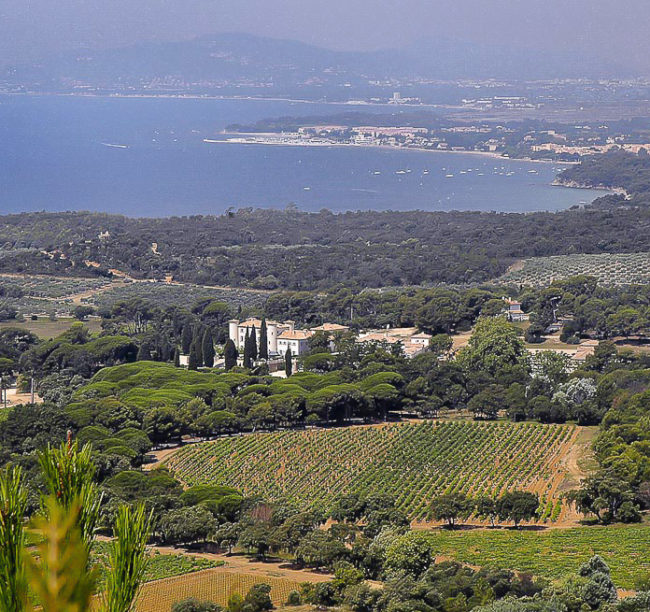
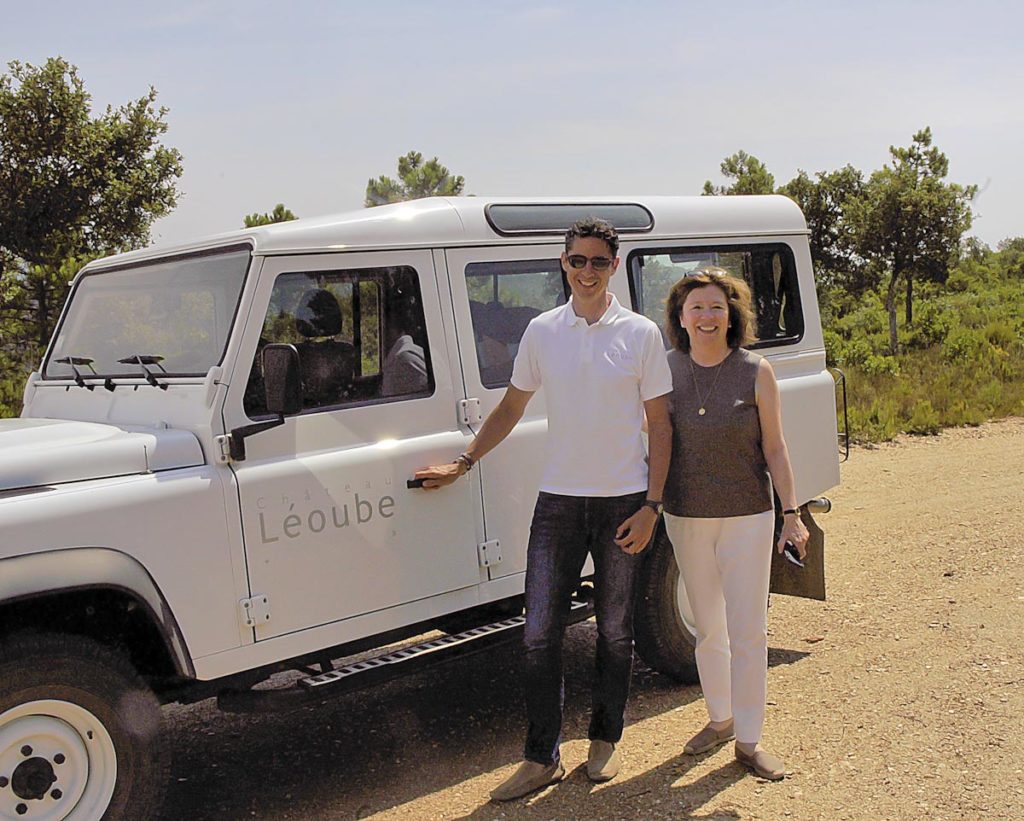
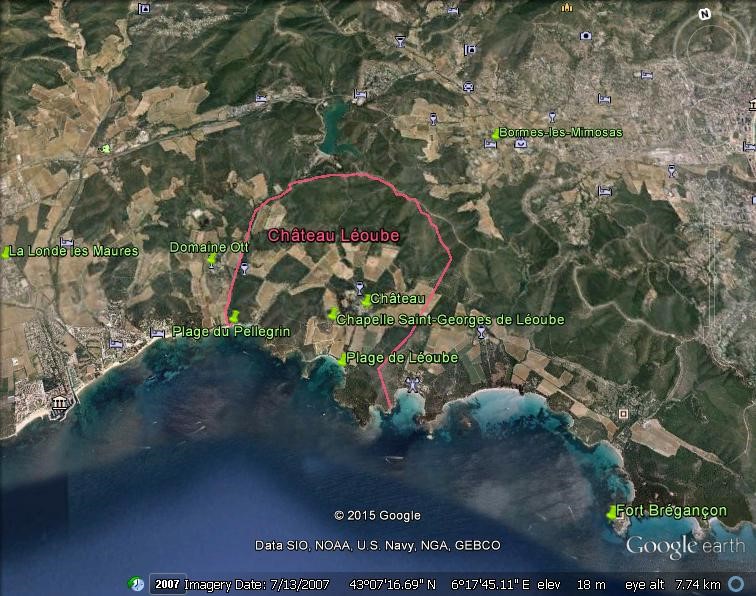
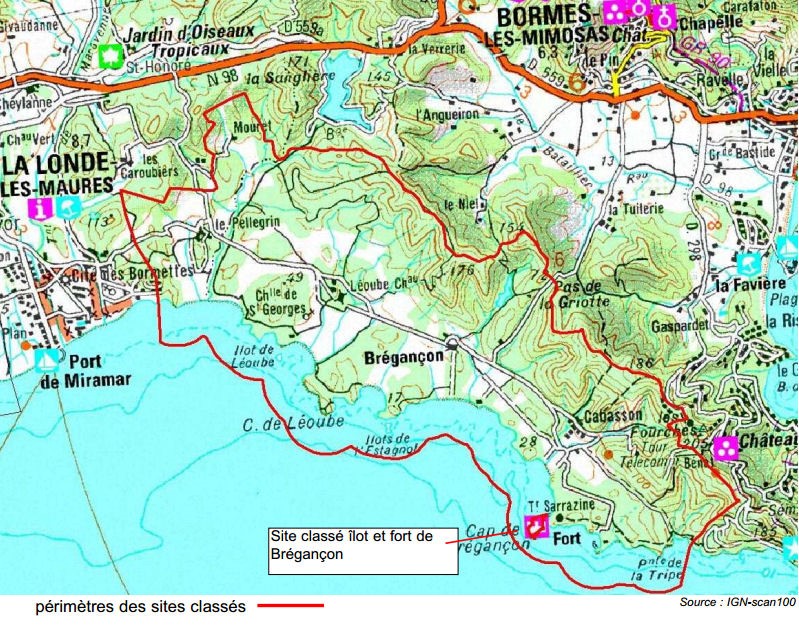
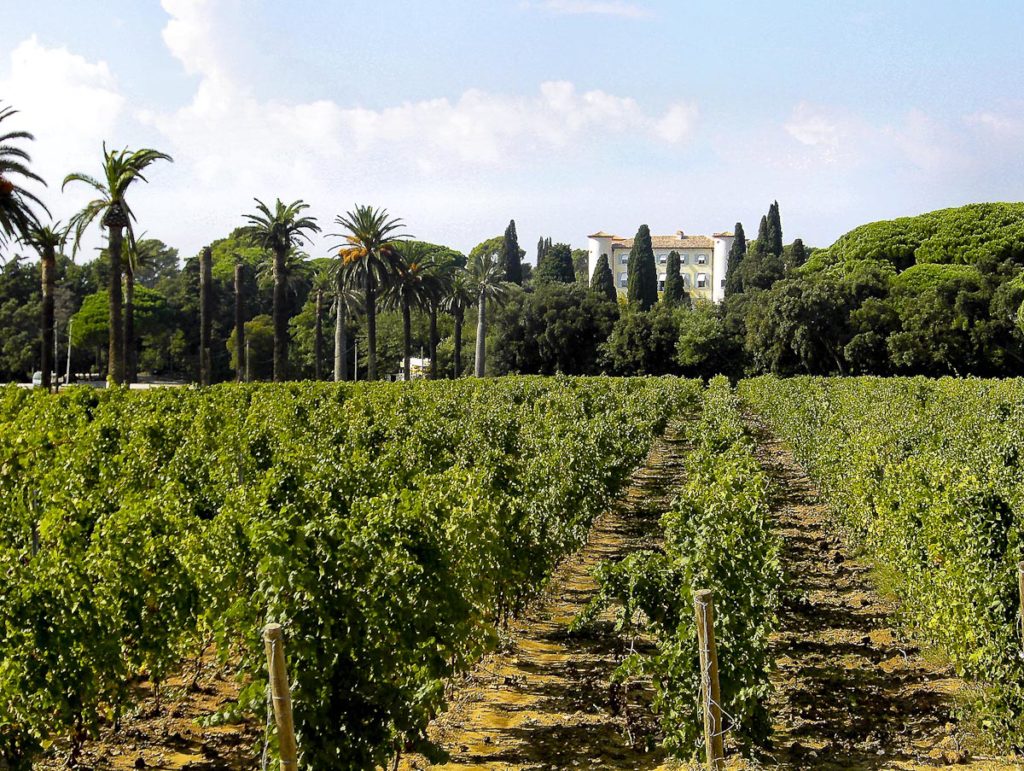
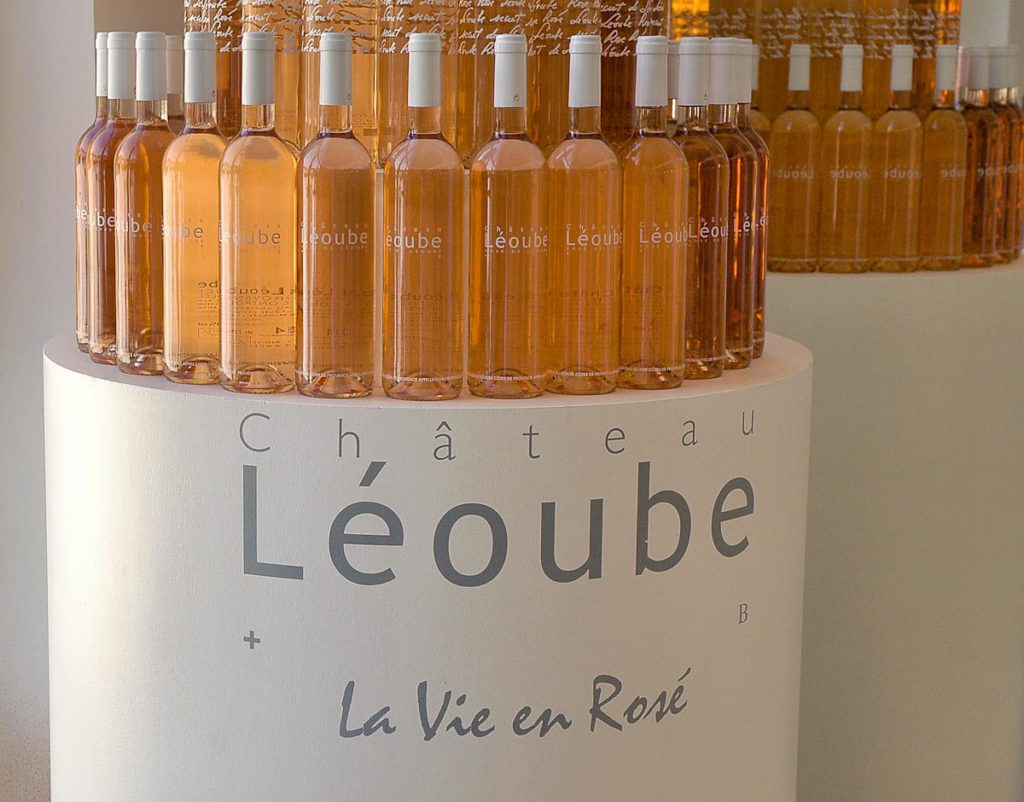
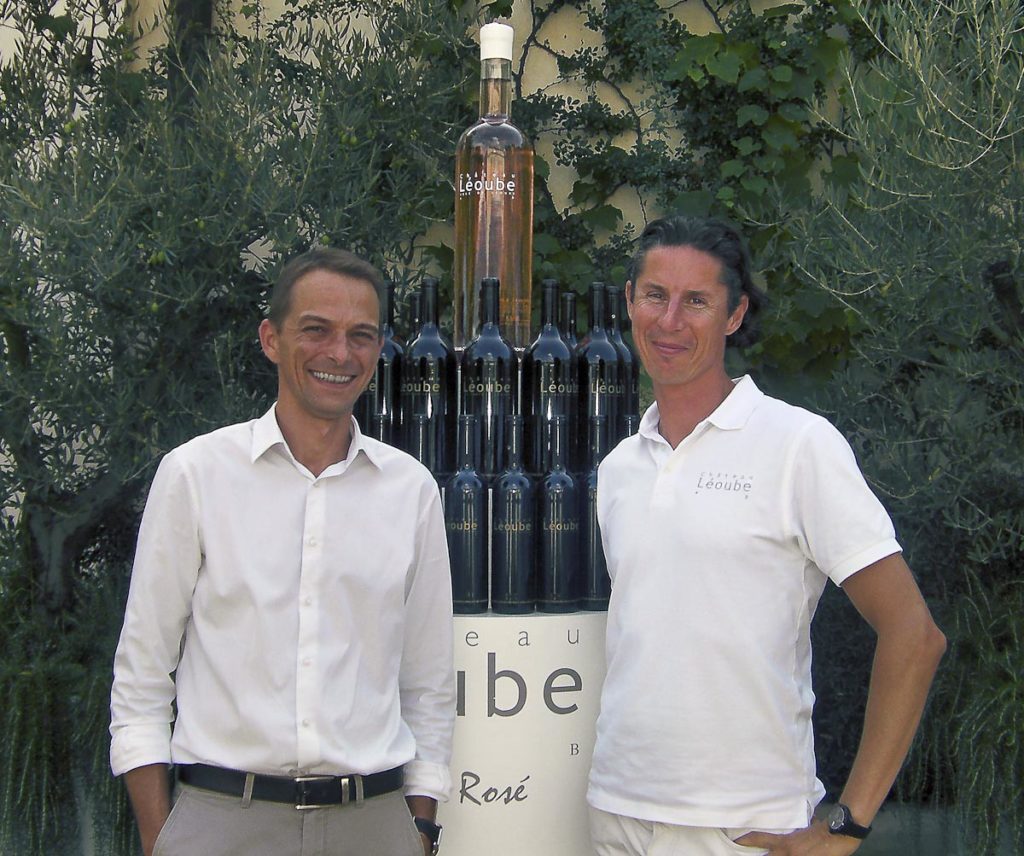
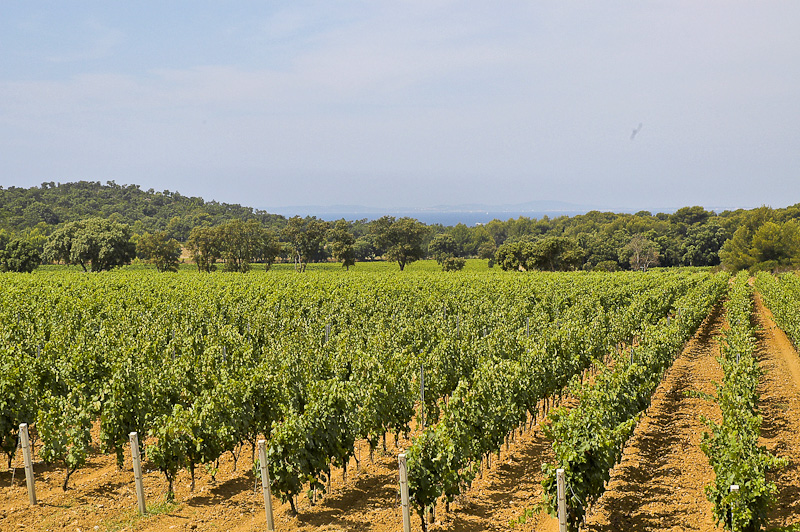
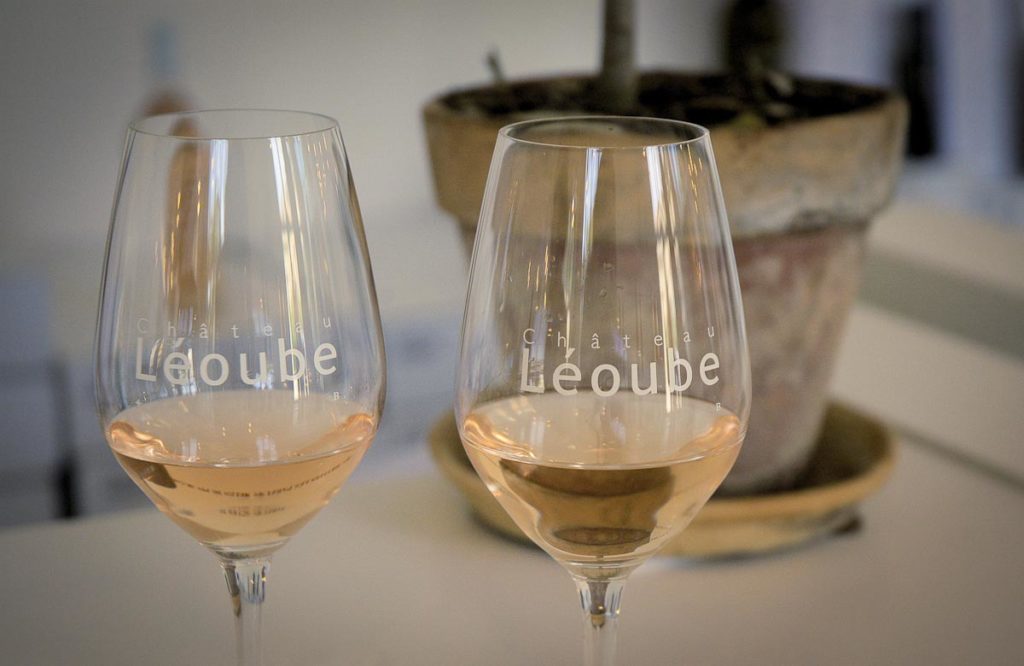
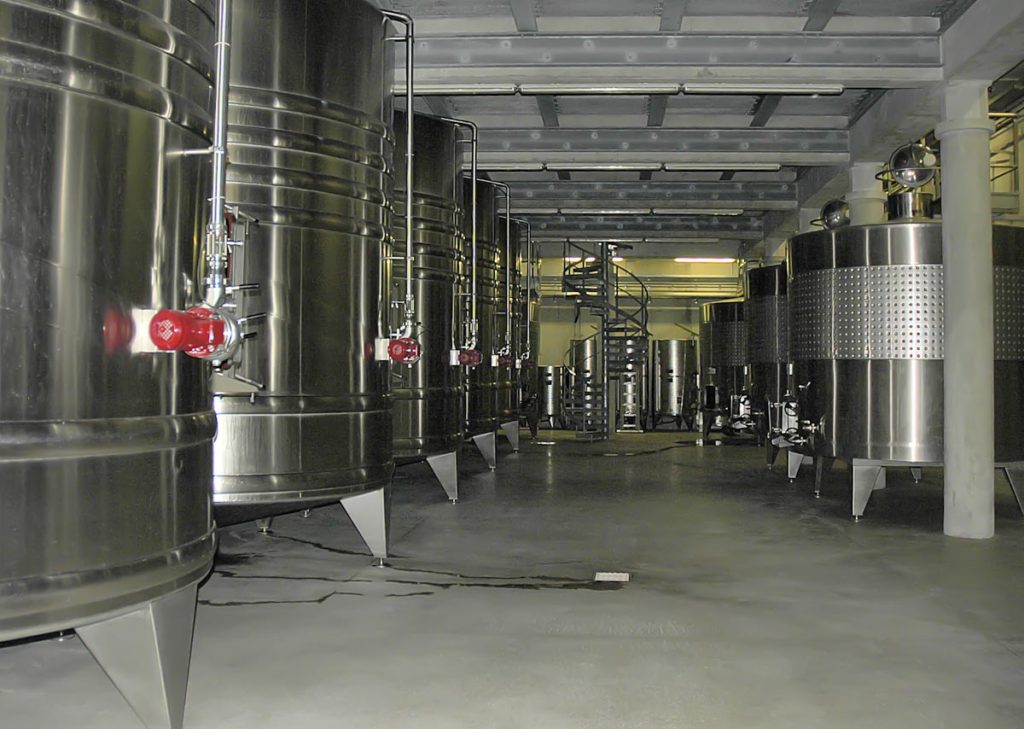
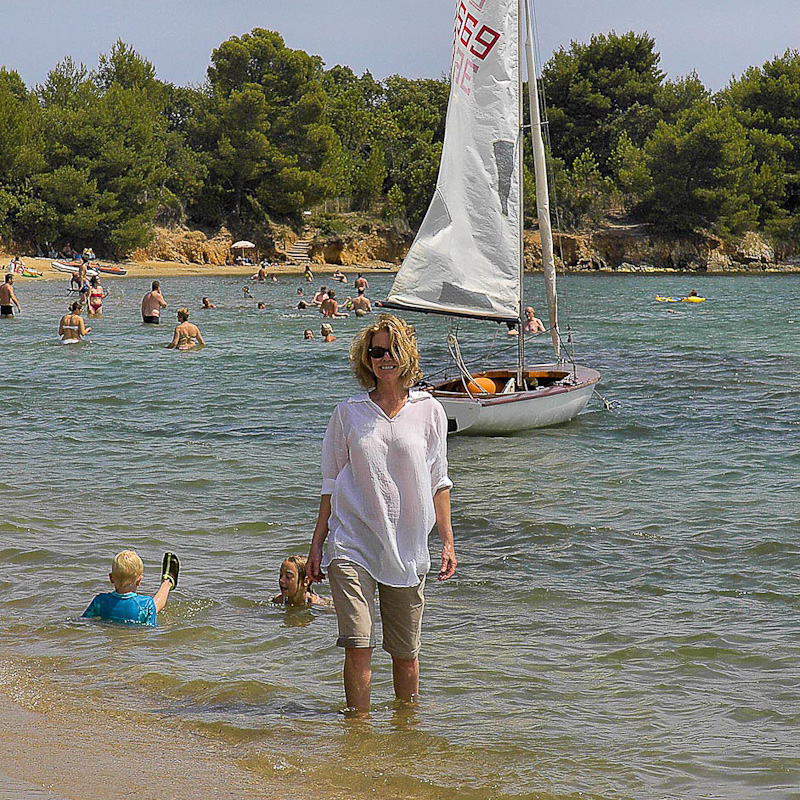
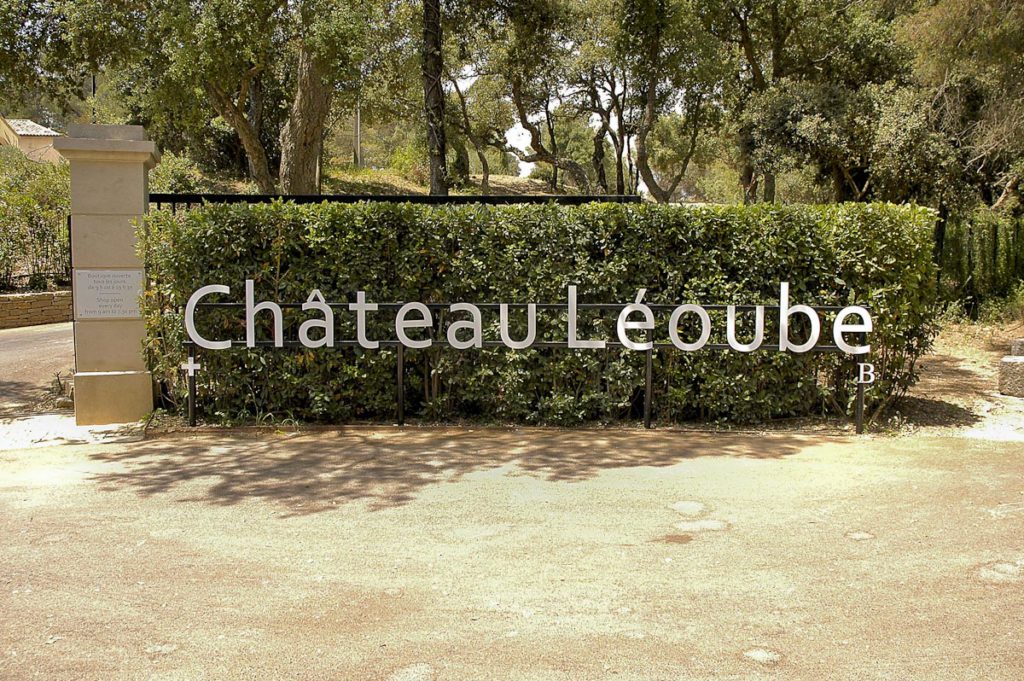
GIRLS, YOU’RE FAMOUS REPORTERS !
PIERRE SCHOTT
Thank you Pierre. We will try and remain humble. You should pay a visit to this domaine, definitely vaut la peine!
Pierre, we wait to read your reports! Many thanks for your faithful readership! Bisous, Susan
Pam – this is a great piece, and I am so very curious about them not wanting the château photographed! A mystery, as you say. Lovely photos, too, and nice to see you chilling on the beach!
Hi David. I’m glad that you enjoyed it. I did read somewhere that the entire château was renovated by the present owners but couldn’t find any “after” photos on the internet. Guess I’ll have to wait to be invited to tea!
Pam,
Most informative and enjoyable reading – truly! Château Léoube should recruit you to create a chap book about their incredible property and its history. As the proud owner of a Citroën 2CV I was especially interested to learn of the George-Marie Haardt connection to the property.
Jerry
Oh, merci Jerry. I would love to know more about previous owners. Perhaps someone will see this article and be able to fill in the blanks. The entire area around the domain would be a great destination for a day trip on your next visit to Provence. Perhaps we can all go together.
Would that all wine reviews were as informative – this is research worthy of “Connections”or “Des Racines et des Ailes”. I only wish it were sufficient to make the “elusive rosé” accessible to our taste-buds. To obtain some we may need to revive Sir Charles Litton of Pink Panther fame – at least we know he is attracted to jewels of rosy hue.
You are very kind Joseph. And brilliant idea – whenever I think of Léoube La Londe, I will have the Pink Panther theme humming in my head. We will have to wait for Susan Manfull’s report on the rosey jewel as she just got her hands on a bottle. Unfortunately for us, it is across the ocean!
Hi Pamela,
A beautifully written and very comprehensive article on the Château Léoube. Well done!
I must definitely try the wine and visit the place.
André
Thank you André. We should plan a Cotignac Wine Association road trip. I would love to visit Fort Brégançon as well. See you at our next meeting!
Hi Pamela
I loved reading this article and it has a special meaning to me. Although a Brit, I live 30 miles east of San Francisco but lived in Provence 2 years ago ( I think part of me is still there!) The first time I tasted Le Leoube rosé was in 2013 when a girlfriend in California, recently introduced to French rosé by myself, bought a bottle from a lovely deli in Lafayette CA, near where we live. Then last year I saw it for sale at Daylesford Barns only discovering the Bamford connection when I later had lunch at the Wild Rabbit. For me such a coincidence, I write a blog as an ‘English girl living in California, in love with Provence’ posting about all 3 places and in England frequently about the Cotswolds, I wrote a post about Daylesford! I also lived in Lourmarin, where Susan lived, I have unsuccessfully tried to get in touch with her. Do tell her I know Walter and was sipping rosé with him Lourmarin just 2 weeks ago! It is such a small connected world Love to be in touch more and do check out my blog! http://www.shuttersandsunflowers.com/blog/category/French%20ambience we should do guest posts for each other!
Yes, small world. I first met Susan when we were in graduate school together in California and have visited the Manfulls many times in Lourmarin. You certainly beat me to the punch in becoming a Léoube fan. Good to know it’s so widely appreciated. I did not know the Bamford connection, either, until visiting the domain. I have heard that the Wild Rabbit is quite a posh pub and was named Pub of the Year in the 2015 Michelin Eating Out in Pubs Guide. I look forward to reading your blog and perhaps we can RDV on your next visit to Provence and toast with un verre de Secret de Léoube!
Well done Pamela,a real delight to read. I am in cold, damp Ireland today and your article transported me back to the warmth of Provence. I can’t wait to visit the Chateau and also the Café de Léoube – it all sounds delightful.
So glad you enjoyed it Patricia. Léoube is in a wonderful beautiful spot and so close to us – no reason not to go. Go find a bottle of Provence rosé. You’ll feel the sun on your face!
Hi Pam, I loved this article, you did a wonderful job! The photos were perfect too. Nice job!!!
Hello Patti. So glad you liked the article. I know you’d love the wine!
Hi Pam ,
Beautifully written and most informative article,thoroughly enjoyed it.
Looking forward to sampling the rose and visiting the Chateau.
Very glad that you liked it, Pamela. A visit to the domain may be in order to stock up on wine for the holidays!
Nice article Pammy, really enjoyed reading it and most informative, great photography too, I recognised a couple of ‘wine tasters’ too. keep up the good work!
Thank you Sharron. And yes, you do know the two discerning wine connoisseurs who accompanied me to Léoube’s portes ouvertes. I’ll be sure to let you know when they’re having the next one.
Having visited the beach often we were delighted to find the café & on leaving the last time the Winery where we were
given a great tasting bought some Wine & will be back,so found your article most interesting with all the history of such à grand place,thanks for the info Pamela.
Lovely article, beautifully written, certainly whets your appetite .
Hello Joy. Yes, Pellegrin Beach is the perfect spot to sip rosé. Susan and I were delighted to discover the café as well – I will be returning next summer.
Annie, thank you. It’s easy to write about Léoube – it has so many facets and is one of my favorite Provence wines. If you’re thirsting for a taste, I just learned that you can order their wines online at infinivin.com or, of course, on their own website chateauleoube.com.
Fascinating article, Pam. The place, the people, the history and of course the wine are so intriguing. Would love to visit someday and will be on the look out for the wine! In the meantime, I will have to just look at your amazing pictures! Best, FF
Hi Tracey. Yes, a fine reason to get yourself to France. Meanwhile, you can pick up a bottle of Léoube rosé next time you’re in New York. Cheers!
a great in-depth article…wonderful to give a sense of place. i am imagining myself there, sipping a good rose. can we expect more from you?
Hi Joan. I would like to see you sitting at Léoube sipping wine as well. Their wine is distributed in California, so you could start sipping there until you get back to Provence.
What a history! What a vineyard! And what a wine! Thankyou Pam for an insightful and interesting article. Jeremy
Hi Jeremy – glad you like. You’ll have to take a spin down to Bormes-les-Mimosas while you’re here in Provence; the domain, the wine, the beach, all incredible.
An amazing article – beautifully written, original research, great photos, a rare delight to read. Congratulations Pam. What a talent.
Thank you Stephanie. So pleased you enjoyed reading about Léoube. We’ll have to wander down there and stock up on the Blanc de Léoube that I know you love.
Great Job Aunt Pammy!
Thanks Timmy. Bottles of Léoube wine would make great Christmas presents for the family!
Great article! Love that I learned a little something (or a lot of something) about the area and history, and not just about the wines! It was so in-depth. Can’t wait to try some of these wines!
So glad, I learned a lot of something too writing the article. You can always pick up a bottle in NY.
Fascinating and informative article Pam – so good I read it twice!!
Clare
xx
You will be twice rewarded in heaven, Clare, or before then if we can share a bottle of Léoube rosé! Thank you.
I especially enjoyed the history and the wonderful photos. Over the years I have only ever viewed this area from the sea, you encourage me to make further exploration by land.. Thankyou.
Yes, it’s a beautiful area that I would like to explore more of as well – and from the sea! So glad you enjoyed the article and, as a wine lover, you should absolutely try the Léoube in all its colors.
When I come visit you’ll have to take me there! Seems beautiful!
It certainly is beautiful and and a visit to Château Léoube will surely be on the agenda when you visit.
Great review. I think I’ll have to visit and check it out myself.
Brilliant idea. I knew the detective in you would need to make his own assessment! Just let me know when you’re coming.
I enjoyed your article regarding the Château Léoubee very much!
As one who truly enjoys the “simple complexities of beer” and a bit history at the same time, I must admit your review of Château Léoubee of only adds to my enthusiam to include travel to The Provence Region to my “bucket list”.
Please contine to write about your what you are obviously so obviously passionate about so that I may consider additonal vineyard to add to my “bucket list”.
Yes, expand that Bucket List to include Provence. In addition to Château Léoube, there are oodles of nearby vineyards and historical sites worthy of any discriminating list. Keep reading Provence Winezine to pick your favorites and count on me for insider tips when you hit the road.
I’m used to spend my summer holidays in the Leoube beaches, and it’s wonderful to see the vineyards so close to the sea in a so well maintained property.
I really enjoyed to read the history of this domain, very informative.
Well done. Thank you.